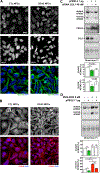Druggable genome screen identifies new regulators of the abundance and toxicity of ATXN3, the Spinocerebellar Ataxia type 3 disease protein
- PMID: 31783119
- PMCID: PMC7050396
- DOI: 10.1016/j.nbd.2019.104697
Druggable genome screen identifies new regulators of the abundance and toxicity of ATXN3, the Spinocerebellar Ataxia type 3 disease protein
Abstract
Spinocerebellar Ataxia type 3 (SCA3, also known as Machado-Joseph disease) is a neurodegenerative disorder caused by a CAG repeat expansion encoding an abnormally long polyglutamine (polyQ) tract in the disease protein, ataxin-3 (ATXN3). No preventive treatment is yet available for SCA3. Because SCA3 is likely caused by a toxic gain of ATXN3 function, a rational therapeutic strategy is to reduce mutant ATXN3 levels by targeting pathways that control its production or stability. Here, we sought to identify genes that modulate ATXN3 levels as potential therapeutic targets in this fatal disorder. We screened a collection of siRNAs targeting 2742 druggable human genes using a cell-based assay based on luminescence readout of polyQ-expanded ATXN3. From 317 candidate genes identified in the primary screen, 100 genes were selected for validation. Among the 33 genes confirmed in secondary assays, 15 were validated in an independent cell model as modulators of pathogenic ATXN3 protein levels. Ten of these genes were then assessed in a Drosophila model of SCA3, and one was confirmed as a key modulator of physiological ATXN3 abundance in SCA3 neuronal progenitor cells. Among the 15 genes shown to modulate ATXN3 in mammalian cells, orthologs of CHD4, FBXL3, HR and MC3R regulate mutant ATXN3-mediated toxicity in fly eyes. Further mechanistic studies of one of these genes, FBXL3, encoding a F-box protein that is a component of the SKP1-Cullin-F-box (SCF) ubiquitin ligase complex, showed that it reduces levels of normal and pathogenic ATXN3 in SCA3 neuronal progenitor cells, primarily via a SCF complex-dependent manner. Bioinformatic analysis of the 15 genes revealed a potential molecular network with connections to tumor necrosis factor-α/nuclear factor-kappa B (TNF/NF-kB) and extracellular signal-regulated kinases 1 and 2 (ERK1/2) pathways. Overall, we identified 15 druggable genes with diverse functions to be suppressors or enhancers of pathogenic ATXN3 abundance. Among identified pathways highlighted by this screen, the FBXL3/SCF axis represents a novel molecular pathway that regulates physiological levels of ATXN3 protein.
Keywords: Drosophila; High-throughput screen; Human embryonic stem cells; Machado-Joseph disease; Neurodegeneration; Polyglutamine; Spinocerebellar ataxia.
Copyright © 2019 The Authors. Published by Elsevier Inc. All rights reserved.
Conflict of interest statement
Declaration of Competing Interest The authors declare that they have no competing interests.
Figures







Similar articles
-
Comparison of spinocerebellar ataxia type 3 mouse models identifies early gain-of-function, cell-autonomous transcriptional changes in oligodendrocytes.Hum Mol Genet. 2017 Sep 1;26(17):3362-3374. doi: 10.1093/hmg/ddx224. Hum Mol Genet. 2017. PMID: 28854700 Free PMC article.
-
Inactivation of PNKP by mutant ATXN3 triggers apoptosis by activating the DNA damage-response pathway in SCA3.PLoS Genet. 2015 Jan 15;11(1):e1004834. doi: 10.1371/journal.pgen.1004834. eCollection 2015 Jan. PLoS Genet. 2015. PMID: 25590633 Free PMC article.
-
A fine balance between Prpf19 and Exoc7 in achieving degradation of aggregated protein and suppression of cell death in spinocerebellar ataxia type 3.Cell Death Dis. 2021 Feb 2;12(2):136. doi: 10.1038/s41419-021-03444-x. Cell Death Dis. 2021. PMID: 33542212 Free PMC article.
-
Toward understanding Machado-Joseph disease.Prog Neurobiol. 2012 May;97(2):239-57. doi: 10.1016/j.pneurobio.2011.11.006. Epub 2011 Nov 23. Prog Neurobiol. 2012. PMID: 22133674 Free PMC article. Review.
-
ATXN3: a multifunctional protein involved in the polyglutamine disease spinocerebellar ataxia type 3.Expert Rev Mol Med. 2024 Sep 25;26:e19. doi: 10.1017/erm.2024.10. Expert Rev Mol Med. 2024. PMID: 39320846 Free PMC article. Review.
Cited by
-
Progressive degeneration in a new Drosophila model of Spinocerebellar Ataxia type 7.Res Sq [Preprint]. 2023 Nov 23:rs.3.rs-3592641. doi: 10.21203/rs.3.rs-3592641/v1. Res Sq. 2023. Update in: Sci Rep. 2024 Jun 21;14(1):14332. doi: 10.1038/s41598-024-65172-4. PMID: 38045332 Free PMC article. Updated. Preprint.
-
Targeting the VCP-binding motif of ataxin-3 improves phenotypes in Drosophila models of Spinocerebellar Ataxia Type 3.Neurobiol Dis. 2021 Dec;160:105516. doi: 10.1016/j.nbd.2021.105516. Epub 2021 Sep 24. Neurobiol Dis. 2021. PMID: 34563642 Free PMC article.
-
Insights into dentatorubral-pallidoluysian atrophy from a new Drosophila model of disease.Neurobiol Dis. 2025 Apr;207:106834. doi: 10.1016/j.nbd.2025.106834. Epub 2025 Feb 5. Neurobiol Dis. 2025. PMID: 39921111 Free PMC article.
-
Identification and Copy Number Variant Analysis of Enhancer Regions of Genes Causing Spinocerebellar Ataxia.Int J Mol Sci. 2024 Oct 18;25(20):11205. doi: 10.3390/ijms252011205. Int J Mol Sci. 2024. PMID: 39456985 Free PMC article.
-
Spinocerebellar Ataxia Type 3 Pathophysiology-Implications for Translational Research and Clinical Studies.Int J Mol Sci. 2024 Apr 3;25(7):3984. doi: 10.3390/ijms25073984. Int J Mol Sci. 2024. PMID: 38612794 Free PMC article. Review.
References
Publication types
MeSH terms
Substances
Grants and funding
LinkOut - more resources
Full Text Sources
Molecular Biology Databases
Research Materials
Miscellaneous

